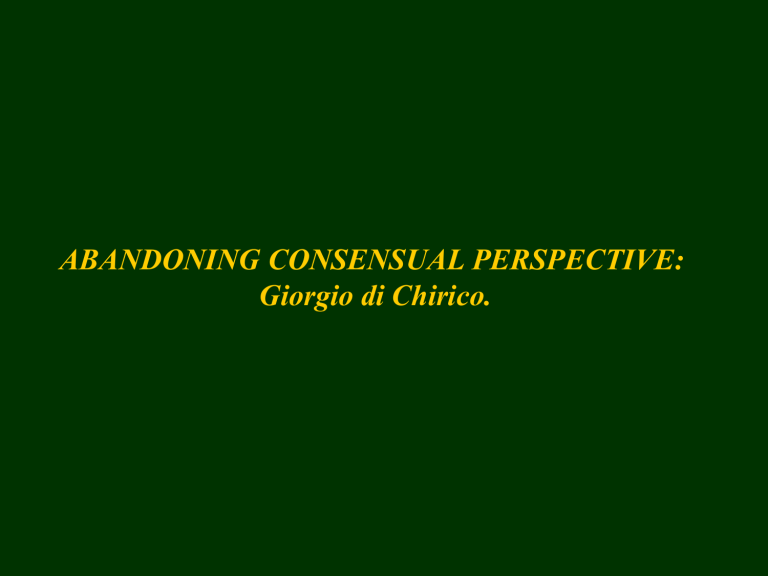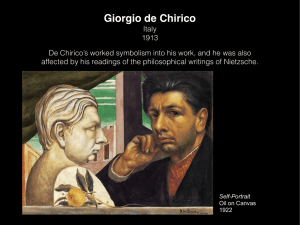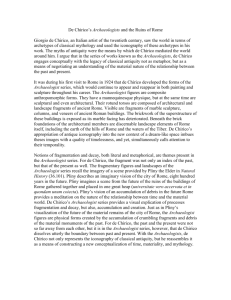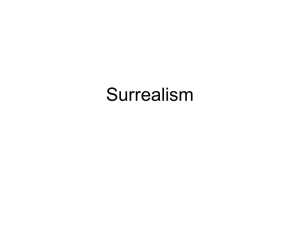ABANDONING CONSENSUAL PERSPECTIVE: Giorgio di Chirico

ABANDONING CONSENSUAL PERSPECTIVE:
Giorgio di Chirico.
In the construction of cities in the architectural form of houses, squares, gardens and public walks, ports, railroad stations, etc., exist the fundamentals of a great metaphysical aesthetic.
Giorgio di Chirico, Metaphysical Aesthetics
Chirico, The Seer
Giorgio di Chirico, Melancholy and Mystery of a Street
Chirico, The Seer, 1915.
Chirico,
Melancholy and
Mystery of a Street, 1914 .
LINEAR PERSPECTIVE, also called scientific, mathematical, or one point, and RENAISSANCE PERSPECTIVE, is an elaboration and standardization of intuitive perspective and was developed in fifteenth century Italy.
It uses mathematical formulas to construct illusionistic images in which all elements are constructed by imaginary lines called orthogonals that converge in one or more vanishing points on a horizon line. Linear perspective is the system that most people living in western cultures think of as perspective. Because it is the visual code they are accustomed to reading, they accept as TRUTH the distortions it imposes.
Stokstad, Art History.
Anonymous, Ideal Italian City, ca 1500
The imbecile, that is, the man without metaphysical sense, is instinctively drawn towards an effect of mass and height, towards a kind of architectural Wagnerism.
They are people who do not know the terror of lines and angles but are drawn towards the infinite.
In this they find support for their limited psyche, closed within the same circle as femininity and childishness.
di Chirico, On Metaphysical Art.
Chirico,
Melancholy and
Mystery of a Street, 1914 .
The absolute consciousness of space which an object must occupy in a painting and of the space which separates objects from each other, establishes a new astronomy of things which are attached to the planet by the fatal law of gravity.
The minutely accurate and carefully determined use of surface and volumes constitutes the canon of the metaphysical aesthetic.
di Chirico, On Metaphysical Art
Other perspectives and other uses of volume, lines and planes are possible!
Hitda Gospels, presentation page, early 11th century
Duccio di Buoninsegna,
Virgin and Child in Majesty,
1308-1311.
BUT WHAT WOULD BE LOST
OR GAINED
IF WE GAVE UP THIS
“SCIENTIFIC”,
“RENAISSANCE”,
PERSPECTIVE?
THIS FIXED FOCAL POINT
ON THE FARTHEST HORIZON?
The imbecile, that is, the man without metaphysical sense, is instinctively drawn towards an effect of mass and height, towards a kind of architectural Wagnerism.
They are people who do not know the terror of lines and angles but are drawn towards the infinite.
In this they find support for their limited psyche, closed within the same circle as femininity and childishness.
di Chirico, On Metaphysical Art.
BUT, GOD IS DEAD . . . .
“Whither is God?” he cried: “I will tell you.
We have killed him -- you and I.
All of us are murderers.
But how did we do this? How could we drink up the sea?
Who gave us the sponge to wipe away the entire horizon?
What were we doing when we unchained this earth from its sun?
Whither is it moving now?
Whither are we moving?
Away from all suns?
Are we not plunging continually?
Backward, sideward, foreward, in all directions?
Is there still any up or down?
Are we not straying as through an infinite nothing?”
Nietzsche, The Gay Science, 1887.
AND
THE CENTER CANNOT HOLD.
The imbecile,. . . the man without metaphysical sense, is instinctively drawn towards . . . the infinite.
Giorgio di Chirico
Chirico, The Seer, 1915.
Chirico, The Seer, 1915.
Chirico, The Seer, 1915.
Chirico, The Seer, 1915.
SCUOLA METAFISICA
To be come truly immortal a work of art must escape all human limits: logic and common sense will only interfere.
But once these barriers are broken it will enter the regions of childhood and dream.
. . . . What I hear is valueless; only what I see is living, and when I close my eyes my vision is even more powerful.
The ancient people of Crete painted an enormous eye in the middle of the narrow bands that circled their vases, on their household utensils, and on the walls of their houses.
One must discover the eye in everything.
Chirico, The Seer, 1915.
PSYCHOLOGICAL AESTHETIC






